How a Book of Paleo Recipes for Kids is
Turning the Southern Hemisphere Upside Down
By Nora Gedgaudas, CNS, CNT, BCHN
The courageous Australian mother of an infant son struggling with the symptoms of “extreme sensory processing issues in the autistic spectrum”, her naturopathic doctor and popular celebrity chef, Pete Evans elected to collaborate on a truly great, healthy recipe book for families with small children, called “Bubba Yum Yum: the Paleo Way For New Mums, Toddlers and Babies”. This heartfelt and brilliantly conceived collection of recipes was mostly created by Charlotte Carr–wife of Australian singer-songwriter (and awesome dad), Wes Carr. Charlotte is also mother to a spectacular, beautiful and now miraculously transformed boy named Willow. Their family naturopathic doctor, Helen Padarin, ND helped with the background research for the book, while Pete mainly offered his own resources, publicity and marketing support to the project, which he also very much believed in. The book is filled with the recipes Charlotte created for her own son as well as for her wonderful www.BubbaYumYum.com web site for other similarly struggling families. The book also includes a specially researched recipe she bottle-fed him with, that happens to contain both quality-sourced liver and healthy, nourishing mineral-rich bone broth (plus other nutritious ingredients). This recipe, more than any other, served to transform the health of her once unreachable son and positively change not only the trajectory of his life, but the lives of everyone around him. It is also this one single bottle-feeding recipe—more than any other in the book—that raised the proverbial hackles of the Dietetic Association of Australia (DAA) and triggered a firestorm of public controversy. “A baby may die” cry the official health authorities! But what’s really going on? Is nutrient-dense liver really potentially deadly? Is vitamin A dangerous? Should we be “protecting babies” from natural foods rich in these nutrients?
THE LOW-DOWN
Just for the record, what we are really talking primarily about here is a food that can be reasonably called the single healthiest and most nutrient dense food in the world, revered by every known indigenous and traditional culture from time immemorial: liver. It does happen to be rich in important preformed vitamin A, along with a plethora of other critical and superb health-building nutrients—including a number of critical and balancing cofactors necessary for the best and healthiest use of preformed, activated vitamin A in the human body.
Inuit girls eat raw seal liver on a summer hunting trip. Igloolik, Nunavut, Canada
Image source: http://www.arcticphoto.co.uk/supergal/ba/ba92/ba9233-09.htm
Fat-soluble nutrients (A/preformed retinol/retinoic acid, D3, E-complex, K1 and especially K2), often rich in organ meats and animal fats, have been undergoing a well-deserved renewed interest by researchers; shedding a fresh, glowing light upon these previously under-appreciated and irrationally feared nutritional rock stars. Dietary fat-soluble nutrients, understood by researchers today as being vitally protective, use intracellular signaling pathways to initiate or modify our environmentally embattled gene expression. And they have also been shown to have a beneficial and direct effect on gene transcription…just for starters…so they have a more-than powerful and unique role to play in human health at any age. And today more than ever.
Yes…I said at ANY age!
Traditional and indigenous diets have always venerated foods rich in fat-soluble nutrients and women either pregnant and/or seeking to become pregnant in traditional and indigenous societies (according to the exhaustive and well-documented research of Dr. Weston A. Price, author of the respected and acclaimed textbook, ‘Nutrition and Physical Degeneration’) ate diets rich in fats and fat-soluble nutrients–including liver–for this very purpose. The notion that these foods have somehow–all of a sudden—become toxic to us at any age is patently absurd. In fact, Price—himself a meticulous researcher in the 1930’s determined that traditional/indigenous societies readily consumed more than 10-times the levels of these nutrients—easily estimable at about 50,000 IU per day of preformed vitamin A, as compared to the levels of vitamin A consumed in (his) “modern times”. And people in Weston Price’s “modern day era” (1930’s) were nowhere near as hysterically phobic about foods such as egg yolks, shellfish and liver as we have since become following the fabrication of irrational concerns about such foods (and animal source foods/fats, in general)! Let’s just say we’re not necessarily healthier as a species for consuming at least ten-times less of these vital and protective, activated fat-soluble nutrients today; much less are we enjoying fewer birth defects or improved overall maternal/infant health. In fact, the closer we as a society attempt to emulate government guidelines, the less healthy (according to the latest confirming research) we demonstrably become.
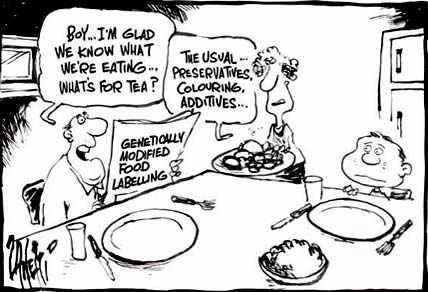
Image source: http://preventdisease.com/news/13/030713_Scientists-Officially-Link-Processed-Foods-To-Autoimmune-Disease.shtml
VITAMIN A 101
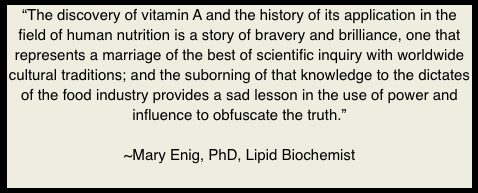
The following passage is borrowed from my own book, Primal Body, Primal Mind:
Critical fat-soluble nutrients, particularly true vitamins A (found only in animal sources) and D, were especially high in primitive and traditional diets—often ten times higher than in modern diets (Price). Beta-carotene, a fat-soluble nutrient, is not, contrary to popular press, the equivalent of vitamin A—nor is its conversion to vitamin A a simple matter. Children under the age of five and individuals with liver or thyroid impairment cannot make this conversion at all.
The conversion also requires the presence of dietary fat. Furthermore, it takes no less than six units of beta-carotene to biochemically form a single unit of vitamin A (Basic Medical Biochemistry). One should never rely solely on vegetable sources for this incredibly vital nutrient. Remember, vitamin A (retinol) is not the same thing as beta-carotene (see molecular diagram below). Cod liver oil can be an excellent supplemental source of true vitamins A and D (mostly A), as well as some omega-3, and may be additionally helpful in the reversal of mineral deficiencies.
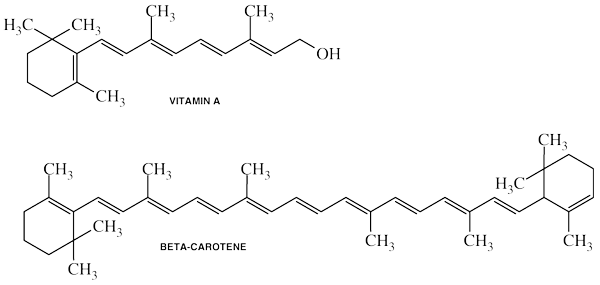
Dr. Mary Enig, world-renowned lipid biochemist of over 50 years stated the following:
“Unfortunately, the vast majority of popular books on nutrition insist that humans can obtain vitamin A from fruits and vegetables. Even worse, FDA regulations allow food processors to label carotenes as vitamin A. The label for a can of tomatoes says that tomatoes contain vitamin A, even though the only source of true vitamin A in the tomatoes is the microscopic insect parts. The food industry, and the lowfat school of nutrition that the industry has spawned, benefit greatly from the fact that the public has only vague notions about vitamin A. In fact, most of the foods that provide large amounts of vitamin A—butter, egg yolks, liver, organ meats and shellfish—have been subject to intense demonization.”
Yes—you heard right again—beta-carotene is NOT vitamin A, as we have been erroneously led to believe! This also includes the carotenes falsely referred to as “vitamin A” found in the much hyped, genetically modified (GMO) “golden rice” touted as some kind of humanitarian engineered food. It is NOT. Beta-carotene and vitamin A are simply NOT interchangeable terms or nutrients, even as they are erroneously classified as being somehow identical! Furthermore, additional research in 1993 shows it likely takes in excess of the aforementioned 6 units of beta-carotene to form so much as a single unit of vitamin A! The amount of vegetables or “golden rice” that would be needed to meet even the most basic human vitamin A requirement would be prohibitive—and that’s assuming one is even capable of making the metabolic conversions to actual vitamin A (which many cannot). Among other conditions interfering with this conversion from supposed plant source “vitamin A” into true vitamin A needed by the body include diabetes, celiac disease (and other malabsorptive conditions), diarrhea, hypothyroidism, pancreatic disease, liver problems, and having no gallbladder. Furthermore, even if you are capable of making these conversions (read: “IF”) you would not be able to rapidly replenish your vitamin A stores following, say, a period of stress or infection or some other pronounced vitamin A need, using vegetables, alone. Intense exercise, periods of physical growth, not to mention pregnancy and lactation are, in fact, stressors that quickly deplete the body’s vitamin A stores.
True, preformed vitamin A (retinol and its derivatives) can ONLY be found in animal source foods.
The conversion from beta-carotene to vitamin A takes place in the upper intestinal tract through the combined action of bile salts and fat-splitting enzymes. Have a thyroid issue, by any chance? Then forget it. Thyroid issues adversely impact healthy biliary function. But also consider this—that vitamin A is 100% essential for normal thyroid health and your thyroid gland cannot function normally without it, requiring even more vitamin A than any other gland in the body! Also, “Strenuous physical exercise, excessive consumption of alcohol, excessive consumption of iron (especially from “fortified” white flour and breakfast cereal), use of any number of popular drugs, excessive consumption of polyunsaturated fatty acids, zinc deficiency and even cold weather can hinder the conversion of carotenes to vitamin A, as does a lowfat diet.” And again, very young children cannot make this conversion at all and must, of necessity, derive this critical and utterly essential nutrient from animal-source organs and fat. Organ meats such as liver are far and away the most reliable natural dietary source!
FAT SOLUBLE NUTRIENTS—YOUR BEST HEALTH’S BEST FRIEND
Dr. Weston A. Price considered the fat-soluble vitamins—and especially vitamin A, to be the catalysts on which all other biological processes depend.
Mind you, various types of nutrients in the diet can affect transcription factors that regulate how our genes are expressed — acting directly, by binding to specific transcription factors (which is the primary mechanism of fat-soluble vitamins), or indirectly, by activating or deactivating transcription factors through peptides like insulin, glucagon, and kinases. These changes in gene expression can in turn encourage or inhibit various internal processes. The fat-soluble vitamins (namely A/ retinol/retinoic acid, D3, E-complex, K1 and K2), when in their activated forms, are uniquely able to enter a cell’s nucleus and bind to nuclear receptors, thereby helpfully modifying the way these genes are transcribed. This is utterly critical for the health of our DNA and our healthiest genetic expression!
Vitamin A in particular is an important antioxidant. It also supports cell growth and differentiation and plays a critical role in the normal formation and maintenance of the heart, lungs, kidneys, and other organs. It is critical for vision as an essential component of rhodopsin, a protein that absorbs light in the retinal receptors, and because it supports the normal differentiation and functioning of the conjunctival membranes and cornea. It is, additionally, critically involved in immune function, vision, reproduction, and cellular communication. Prior to the development (and lucrative patenting) of antibiotics after World War II, vitamin A was the primary focus of anti-infective therapy and immune functioning enhancement. In fact, clinical trials conducted and published in the 1930’s showed that cod liver oil (a literal superfood that is particularly rich in naturally occurring, preformed vitamin A) could actually reduce the incidence of colds by fully a third and demonstrably cut hours missed from work (and the lost income that goes with that) in half!
THE MANY, VERY REAL DANGERS OF VITAMIN A DEFICIENCY

Image source: http://pixgood.com/vitamin-a-deficiency-eye.html
According to the World Health Organization (WHO) web site:
Vitamin A deficiency (VAD) is the leading cause of preventable blindness in children and increases the risk of disease and death from severe infections. In pregnant women VAD causes night blindness and may increase the risk of maternal mortality.
Vitamin A deficiency is a public health problem in more than half of all countries, especially in Africa and South-East Asia, hitting hardest young children and pregnant women in low-income countries.
Crucial for maternal and child survival, supplying adequate vitamin A in high-risk areas can significantly reduce mortality. Conversely, its absence causes a needlessly high risk of disease and death.
- For children, lack of vitamin A causes severe visual impairment and blindness, and significantly increases the risk of severe illness, and even death, from such common childhood infections as diarrhoeal disease and measles.
- For pregnant women in high-risk areas, vitamin A deficiency occurs especially during the last trimester when demand by both the unborn child and the mother is highest. The mother’s deficiency is demonstrated by the high prevalence of night blindness during this period. The impact of VAD on mother-to-child HIV transmission needs further investigation.
A Few Salient Facts:
- An estimated 250 million preschool children are vitamin A deficient and it is likely that in vitamin A deficient areas a substantial proportion of pregnant women is vitamin A deficient.
- An estimated 250,000 to 500,000 vitamin A-deficient children become blind every year, half of them dying within 12 months of losing their sight.
(added emphasis through the use of underlining and italics above mine)
Furthermore, vitamin A deficiency contributes to poor outcomes in pregnancy and lactation and leads to greater maternal mortality.
Mind you, this sort of mortality and pathological clinical deficiency is “seemingly” far less prevalent (or identified, anyway) in developed countries—but this doesn’t mean that the rest of us are necessarily enjoying all the benefits or even the reality of full vitamin A sufficiency.
According to the World Health Organization/WHO, the definition of vitamin A deficiency is not at all easily determined:
Definition of vitamin A deficiency
VAD is not simply defined. WHO defines it as tissue concentrations of vitamin A low enough to have adverse health consequences even if there is no evidence of clinical xerophthalmia (16). In addition to the specific signs and symptoms of xerophthalmia and the risk of irreversible blindness, non-specific symptoms include increased morbidity and mortality, poor reproductive health, increased risk of anaemia, and contributions to slowed growth and development. Because these non-specific adverse consequences may occur from other nutrient deficits as well, it is difficult to attribute non-ocular symptoms specifically to VAD in the absence of biochemical measurements reflective of vitamin A status.
Also, since vitamin A is essential to the healthy differentiation of all tissue cells a deficiency has also been linked to increased risk for cancers—and cancer is rapidly on the increase worldwide in all industrialized nations. In fact, the WHO is predicting a 70% increase in cancers worldwide over the next 20 years. Vitamin A and its various true forms are considered among the more promising realms of cancer therapeutics. A naturally chemotherapeutic agent, retinoic acid and its derivatives have been used to treat many types of tumors. The anti-tumor effects are due in part to the ability of preformed vitamin A and its natural derivatives to inhibit proliferation of cancer cells (and seemingly also help restore healthy cellular differentiation).
But what about the other effects of merely insufficient or what is referred to as “subclinical” (as opposed to pathological) vitamin A deficiency? Hmmm…let’s see….
Symptoms and signs of sub-clinical vitamin A deficiency signs and symptoms can include:
Night blindness and/or a pronounced visual sensitivity to bright light, dry eyes, dry hair, acne, vertical ridges on fingernails/peeling fingernails, a lowered resistance to infections (in general); including: increased susceptibility to eye infections, acute/chronic viral infection of all types, infections of sinuses/nasal passages, middle ear/ear infections in general, pharynx, mouth, lungs/respiratory tract infections and infections of the urinogenital tract (including the possible development urinary calculi/stones).
Vitamin A is also absolutely required for the maintenance and uncompromised functioning of all mucous membranes in your body (protecting you from bacterial and other pathogenic infiltration). Chronic problems with this may be part-and-parcel of a greater dietary vitamin A need.
Low levels of vitamin A can also lead to dry, rough, scaly skin and—not uncommonly–chronically raised “goose-bumps” found on the upper arms and thighs. Even sub-clinical vitamin A insufficiency can additionally result in impaired digestion, diminished secretion of digestive juices, lack of absorption and increased susceptibility to intestinal infection and diarrhea.
Hmmm…How many people do you know that chronically suffer from conditions such as these? Still think vitamin A insufficiency is some kind of rarity?
In fact, according to Dr. Alfred Sommer, ophthalmologist and epidemiologist at the Johns Hopkins Bloomberg School of Public Health, even mild, subclinical deficiency can also be a problem, as it may increase children’s risk of developing respiratory and diarrheal infections, decrease growth rate, slow bone development, and decrease likelihood of survival from serious illness. Sommer was the winner of the Albert Lasker Award for Clinical Medical Research in 1997 and the Danone International Prize for Nutrition in 2001.

Dr. Sommer examines a child for xerophthalmia in Bandung, Indonesia, 1976.
In fact, thanks to his research in the 1970’s and 1980’s, the World Bank (1993) and, more recently, in 2008 the Copenhagen Consensus listed vitamin A supplementation as one of the most cost-effective health interventions in the world!
Sommer dedicated his life to researching the cause, magnitude, consequences, and control of vitamin A deficiency. He received his MD from Harvard Medical School and his MHS from the Johns Hopkins School of Hygiene and Public Health.
Sommer used vitamin A to save countless lives. How many more could be further improved by simply moderately increasing the consumption of naturally vitamin A-rich foods; even in the modern industrialized world? Is the demonization of this extraordinary nutrient serving anyone—babies included?
Vitamin A deficiency has even been implicated in Sudden Infant Death Syndrome (SIDS)! Far from being a threat to any unborn fetus, The Nordic Epidemiological SIDS Study found an association between low or no vitamin A intake and an increased risk of sudden infant death syndrome (SIDS) during their first year of life. This finding remained conclusive even when an adjustment was made for potential confounders, including socioeconomic factors. Furthermore, substantial evidence exists to show that healthy vitamin A levels during pregnancy in the mother may results in substantially reduced HIV transmission risk to her unborn child (also, vitamin A-deficient mothers were much more likely to transmit the virus to their newborn infants than were HIV-infected mothers who had adequate amounts of this critical nutrient).
Still think pregnant mothers and their babies should be fearing too much vitamin A?
Keep reading.

Image source: http://www.consciouslyenlightened.com/?p=45
So what’s the greater risk, do you suppose? Too much dietary vitamin A from real foods…or too little?
Was Alfred Sommer wringing his hands and losing sleep over the potential for vitamin A toxicity in anyone? It seemed to him, as it would seem to any rational, educated person looking at this issue in any real depth that by far the greater danger in the world is too little vitamin A in the modern diet and not too much. In Dr. Weston A. Price’s time alone, levels of dietary vitamin A in primitive and traditional diets were (by his own observable estimation as written in ‘Nutrition and Physical Degeneration’) over TEN TIMES GREATER than preformed dietary vitamin A levels today–along with other essential naturally occurring fat-soluble nutrients in primitive and traditional diets needed for healthy vitamin A utilization.
Now I’ve got another question for you: how many people do you know—or have you even heard of suffering from either vitamin A toxicity—or (for that matter) dying from a diet “too high” in naturally vitamin A-rich foods?
Anyone? Bueller?
I didn’t think so.
I personally scoured the Internet searching for ANY documented examples of death due to vitamin A toxicity. I found a 2004 Poison Control Center report where a total of 3 deaths out of tens of thousands from innumerable causes that entire year were a supposed result of “vitamin overdose”. Allegedly, two of the deaths were attributed to vitamins’ D (and the most common mechanism of D toxicity is associated with vitamin A and K deficiency,) and E (highly questionable) plus one 1 from a “polyvitaminic type formula, with iron” (cheap inorganic and/or physician-prescribed inorganic iron supplements like ferrous sulfate and/or iron oxide—NOT heme-iron-rich foods– create all the overdose emergencies and complications). By contrast, the previous year in 2003, 59 confirmed deaths were recorded as due to aspirin poisoning and 147 deaths were associated with acetaminophen-containing products. –And that’s just two of many potentially toxic over the counter drugs.
In fact, zero deaths in 19 of 27 years were ever even potentially attributable to supposed “vitamin toxicity” of ANY kind, period—but a newer analysis and further evaluation of US Poison Control Center annual report data (as of June 2011) indicates that there have, in fact, been no deaths whatsoever from vitamins . . . none at all, in the 27 years that such reports have been available. Even if there were 1 death due to vitamins per year, then the US death rate for drug overdose (not to mention prescription drug use) would still be minimally tens of thousands of times more than that of all vitamins and herbs. Furthermore—and more to the point:
No deaths or reports listed in these Poison Control Center reports out of tens-of-thousands (of any age) were attributed to vitamin A toxicity from naturally occurring whole food (or any other vitamin A source, for that matter).
Chew on that for a while.
Each year, overdoses of acetaminophen (sold as Tylenol and other brands) account for more than 56,000 emergency room visits and an estimated 458 deaths from acute liver failure. How about this: NSAID drugs such as Ibuprofin are the among THE most widely used over the counter medications in the world—and are known to DOUBLE a person’s risk of heart failure (among a plethora of other serious risks and common potential complications), plus (hardly worth mentioning under the circumstances) doubling a woman’s risk of miscarriage during early pregnancy.
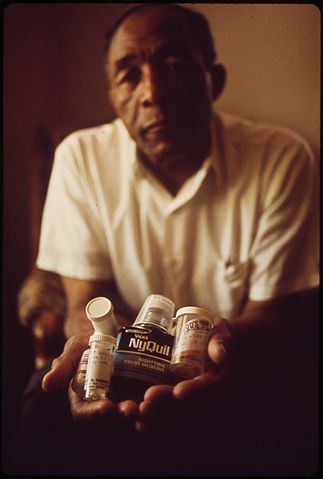
Image source:
http://commons.wikimedia.org/wiki/File:MEDICATIONS_USED_BY_DAMAGED_LUNG_VICTIMS_-_NARA_-_545424.tif
Why aren’t public health authorities instead decrying and discouraging not just the rampant potentially dangerous over-use of over-the-counter medications (many of which have been proven not only ineffective, but even fatal to children, while still being sold even as the dangers are known), but also toxic, supposedly “properly prescribed” prescription medications which kill an average of more than 100,000 persons per year—more than all the deaths of American soldiers in all the years of Viet Nam combined—EACH AND EVERY YEAR?
But instead we’re reading tabloid and sensationalist “health authority” sanctioned rubbish about concerns over natural, organic, whole food-based liver and bone broth recipes in Bubba Yum Yum potentially killing babies. Yet where is the evidence for this?
Answer: there isn’t any.
Wait—ZERO deaths from dreaded dietary liver or vitamin A toxicity? No dead babies from liver formulas? How can this be? Let’s keep looking… In 2010, there were supposedly 15 reactions attributed to supplemental vitamin/mineral “overdoses” out of tens of thousands of reports (none related to vitamin A) but…no deaths? 2011, 2012, 2013…still no vitamin A deaths. Not even a single baby? What is this world coming to??!
I kept digging. SOMEWHERE online there had to be a graveyard full of grisly death attributions to food-based vitamin A toxicity.
Then finally—there it was!
Somewhere between 1911-1912, three intrepid but hapless Australian Antarctic explorers, Douglas Mawson, Xavier Mertz and Briton Belgrave Ninnis were busy navigating the frozen and treacherous Antarctic coast. They lost their supplies in a tragic mishap when Ninnis fell into a crevasse and was killed. Mawson and Mertz—having lost everything else– were reportedly forced by starvation to eat their huskies. Both of them were supposedly poisoned (and Mertz died)—allegedly from eating the livers of these sled dogs during this frigid misadventure.
AHA!! At last!!! –Evidence!! The Grim Reaper’s sinister friend—eeevil vitamin A strikes its mortal blow!
Oh, wait…upon further examination of the evidence I came across a study surrounding this Antarctic misadventure that suggested that “exhaustion, food deprivation and diet change” were more likely to have caused the tragedy than vitamin A poisoning.
D’OH! What is a witch-hunter to do???
DOING THE POLAR BEAR POLKA
Other popular and seemingly “promising” vitamin A toxicity lore surrounds the purported toxicity of polar bear liver in the Arctic, and urban/rural legend has it that polar bear liver consumption (having a purported whopping one million units per gram of pure, preformed vitamin A) did-in its share of liver-craving polar explorers, back in the day. Back to the books I went, in eager anticipation of the easy mortality evidence I was seeking. I will admit to personally believing these hyped oldwives tales might actually be true myself, and half-expected to find something.
In 1855 a book titled ‘Arctic Explorations’ written by Arctic explorer Elisha Kane did claim that the polar bear liver “of a well-fed cub” could bring on feelings of illness (ok—we’re getting warmer…). Kane and his crew reported that they often ate their huskies as well, but there is no mention in the book of illness through the consumption of husky liver, as somewhat dubiously reported by Mawson.
Quoting from Kane: (p. 222-3)
When I was out in the Advance with Captain De Haven, I satisfied myself that it was a vulgar prejudice to regard the liver of the bear as poisonous. I ate of it freely myself and succeeded in making it a favorite dish with the mess. But I find to my cost that it may sometimes be more savory than safe. The cub’s liver was my supper last night, and today I have symptoms of poison in full measure – vertigo, diarrhea, and their concomitants.
Yep—despite all the presumed vitamin A toxicity he lived. But in truth who knows what it really was that actually even made him sick.
Quoting from Kane (p. 220):
“Bears in this lean condition are much the most palatable food. The impregnation of fatty oil through the cellular tissue makes a well-fed bear nearly uneatable. The flesh of a famished beast, although less nutritious as a fuel diet, is rather sweet and tender than otherwise.”
Quoting from Kane (p. 264-5):
“I do not know that my journal anywhere mentions our habituation to raw meats, nor does it dwell upon their strange adaptation to scorbutic disease. Our journeys have taught us the wisdom of the Esquimaux appetite, and there are few among us who do not relish a slice of raw blubber or a chunk of frozen walrus beef. The liver of a walrus (awuktannuk) eaten with little slices of his fat – of a verity it is a delicious morsel. Fire would ruin the curt, pithy expression of vitality that belongs to its uncooked juices. Charles Lamb’s roast pig was nothing to awuktanuk.”
On the other hand, on p. 265:
“Our sick have finished the bear’s head and are now eating the condemned abscessed liver of the animal, including some intestines that were not given to the dogs.”
Doesn’t sound appetizing, mind you, but no report of any death or even illness associated with this.

Supposedly this sheet music by Sarony, Major & Knapp, was dedicated to Kane, 1856.
Image source: http://wiki.houptlab.org/wiki/File:Image-PolarBearPolka.jpg
There were several additional study citations I came across related to polar explorers and polar bear liver (and the liver of other arctic sea and land mammals) for which there was no current online text to be found. Many were dated back to the 1940’s. Perhaps somewhere buried in the oxidized parchment of some now elusive and long-gone peer reviewed journal lies evidence of vitamin A’s truest natural food-based dangers. In the meantime, I’m stumped.

It turns out that serum retinol levels are closely regulated by the liver and remain relatively stable despite major fluctuations in dietary intake. Symptoms of toxicity, which by the way tends to be quite rare, seem to be almost entirely transient in most every case.
A pretty thorough 2002 study titled “Estimating the Potential for Vitamin A Toxicity in Women and Young Children” published in the Journal of Nutrition looked closely at this very issue and stated the following:
“There are few data on which to establish thresholds for excessive vitamin A intake or vitamin A concentrations in tissues. To assess the potential toxicity of the new recommendations (see article by Ross in this issue) for high dose vitamin A supplements for infants and children, we used a kinetic approach to estimate accumulation of the vitamin in liver. The new recommendations are unlikely to result in toxic levels (>300 μg per gram of liver) even if high dose supplements are inadvertently given monthly. The kinetic analysis also illustrates that a constant supply of vitamin A from breast milk (and/or complementary foods) is vital for preventing depletion of liver vitamin A stores between high dose supplements.” (bold emphasis mine)
The article did go on to say that:
“Humans normally obtain preformed vitamin A from animal products in the diet and provitamin A carotenoids (mainly β-carotene) from fruits, vegetables and oils. Consuming natural sources of vitamin A rarely results in toxicity. The exception is toxicity resulting from excessively high intakes of carnivore liver on a continued basis. Liver contains 3000–5000 μg of retinol per 100 g. Although this level of intake is rare, a case study reported vitamin A toxicity symptoms in a 7-mo-old infant who was given ∼12,100 μg of retinol/d, mostly in chicken liver (1). The vitamin A content of this food is high (5000 μg/g).” (note—μg/microgram is a very different unit of measure from IU or milligrams—By way of comparison, the amount of vitamin A (retinol) found in the Bubba Yum Yum liver-containing “Happy Tummy Brew” recipe per maximum 200 ml serving—by stark contrast—is a mere 6.25 μg—that’s micrograms—each microgram equal to 1/1000th of a milligram).
Then the study’s authors go on to say: “To the best of our knowledge, a dose of 50,000 iu (15 mg) of vitamin A is safe for infants before 6 mo, but doses larger than that should not be given, especially to children under the age of 4 mo (3).
In young children, 100,000 iu (30 mg) of vitamin A at 6–11 mo and 200,000 iu (60 mg) every 3 to 6 mo for children aged 12–60 mo, gives few side effects and is effective for reducing mortality (15). In 1980 a 300,000-iu dose—a higher level than is now recommended—produced a 6% incidence of vomiting and a 16% incidence of transient diarrhea in Indonesian preschoolers (16). Doses of 100,000 and 200,000 iu caused nausea, vomiting, headache, diarrhea and fever among some children in the Philippines (17). The incidence of these symptoms was higher with the larger of the two doses and among the smallest children during the first 2 y of life. Thus, transient nausea and vomiting are expected in 5–10% of the youngest children receiving these doses (3). (bold emphasis mine)
Are you paying attention and doing the math here? Just checking.
Later in the same article the authors stated clearly that:
“Symptoms of acute toxicity are usually mild and transient.”
Chronic toxicity could occur in an individual who commonly consumes supplements or frequently eats foods with high vitamin A content, such as liver (3) and can lead to severe liver damage. It is thought to require ingesting at least 30 mg of preformed retinol per day [100,000 iu or about 40 times the recommended dietary allowance (RDA)] for months or years (23–26).” (bold emphasis and enthusiastic underlining mine)
The Merck Manual reports that acute vitamin-A poisoning can occur in children after taking a single dose of synthetic vitamin A in the range of 300,000 IU or a daily dosage of 60,000 IU for a few weeks. Hardly an indictment of liver consumption.
SO WHERE DID ALL THIS MISPLACED VITAMIN A HYSTERIA
COME FROM IN THE FIRST PLACE?
The overly low standard recommendations for vitamin A intake when it comes to anyone—but most importantly pregnant women and babies is, according to both biochemist and researcher Chris Masterjohn and also renowned lipid biochemist and researcher, Dr. Mary Enig–almost entirely based on a single poorly designed study published in 1995 that claimed to report an increased risk of birth defects among women having an intake of more than 10,000 IU per day of vitamin A. In fact, most every other vitamin A study apart from the aforementioned 1995 study conflicts with its findings and has found preformed vitamin A dietary levels exceeding 10,000 IU to be not only safe, but even desirable!
One major study of over 25,000 births following the 1995 study showed that daily doses of vitamin A up to 40,000 IU cut the risk of birth defects in half! In this study, doses of vitamin A over 40,000 IU per day carried a 2.7-fold higher risk of birth defects, but doses of vitamin A up to 20,000 IU or between 20,000 and 40,000 IU both carried a 50 percent lower risk of birth defects compared to no supplementation!
When one considers the prized value among traditional and indigenous societies of organ meats and especially liver (especially as compared to our modern day culture) —consumed far more regularly than today—the conclusions arrived at in the ill-designed 1995 study simply don’t add up. At the turn of the last century almost everyone alive recognized, as common knowledge, the incredible nutritional value of liver as a regular inclusion to the diets of everyone (including young children). No one back then feared (or had any reason to fear, as none should today) liver as a potential source of any concern, much less “vitamin A toxicity”. Why such a poor study—flawed as it was—was selected as the cornerstone of such a critical and severely misguided government policy is beyond comprehension.
In the aforementioned questionable 1995 Boston University study which was responsible for heralding the modern day anti-vitamin A campaign, the researchers basically followed almost 23,000 women over the course of their pregnancies and purportedly found that women who consumed more than 10,000 IU of vitamin A during the first trimester gave birth to offspring with a “2.4-fold greater risk of total birth defects” and a “4.8-fold greater risk of cranial-neural-crest defects” (a rather broadly defined group of defects whose classification here has been found by other researchers to be highly controversial. Later, three groups of experts wrote to the journal questioning the authors’ odd classification of cranial-neural-crest defects). In the study, among the 188 women who consumed this amount of vitamin A from supposedly “food” alone, there was purportedly an 80 percent increase in the risk of total birth defects and two times the risk of (the dubious) cranial-neural-crest defects. Because there were so few women consuming vitamin A from “food” alone, however, the researchers could not conclusively distinguish the association from the possibility of chance. One major issue with this study, however (among many) is that no blood work was ever taken to assess the mothers’ actual vitamin A status and the researchers based their data collection entirely upon the highly inaccurate method of using questionnaires and relying on subject recall.
Uh…what did YOU have for lunch last Thursday?
The aforementioned 1995 study was simply loaded with head-scratching issues. Apart from those already touched upon, the researchers entirely failed to distinguish between manufactured vitamin A in the form of supplements and/or added to processed foods, and natural vitamin-A complex, automatically occurring in foods like liver, cod-liver oil, shellfish, butterfat and egg yolks with numerous essential co-factors required for its healthy metabolism. The authors also did not distinguish at all between various actual whole food and so-called “food-like” processed sources—and most so-called “food” source vitamin A in industrialized modern-day society comes from synthetically fortified processed foods, particularly breakfast cereals. Of course, it would seem to me that anyone getting most of their vitamin A from “officially” approved “fortified foods” and breakfast cereals—loaded with sugar, gluten, pesticide residues, artificial colors, additives and preservatives would be bound to wind up with a few birth defects—if they were lucky.
Other studies showing any association of birth defects with vitamin A involved things like topical creams containing side-effect-riddled vitamin A derivatives such as Accutane, or extremely high doses of synthetic A (taken alone—away from other vitamin-A cofactors) mainly reported in animal studies.
Last but not least—as Masterjohn has most observantly pointed out, the authors of the 1995 study seemed to have underestimated the rate of certain types of birth defects that are known to occur “normally”. The rate of total birth defects among the 20,000 women consuming less than 10,000 IU was only 1.5 percent; however the generally accepted base background rate is 3-4 percent. The rate of defects among the 3,000 women consuming more than 10,000 IU of vitamin A was 3 percent—basically on the lower end of what is typically considered normal!
Possibly the most obvious and common sense objection to this study is the fact that it conflicts with virtually all the other available evidence.
Considering the history of human vitamin A intake (through widespread consumption and preference for organ meats) from time immemorial, the ubiquitous role of vitamin A in the development of every organ system of the body and how tightly the body naturally regulates the level of the activated form, we should expect a regular and substantial helping of vitamin A-rich organ meats and animal fats to actually help fetal and infant development, not cause a plethora of abnormalities in babies and other problems, much less posing any sort of “health risk”. The preponderance of the abundant research evidence, paired with pure garden-variety logic, plus the added evolutionary and traditional context with respect to innumerable indigenous and traditional cultures suggests that vitamin A is overwhelmingly beneficial—and always has been– and is far from being “dangerous” to anyone.
Later, others continuing research into the health effects of vitamin A ultimately determined that after serum testing and determining safe serum levels, women taking 30,000 IU of preformed vitamin A from animal foods (not beta-carotene) daily had the same blood levels of A as healthy pregnant women in the first trimester who had healthy babies. The conclusion was that a dosage over 30,000 IU vitamin A daily “might” be teratogenic for a certain few, but anything up to that amount is—from the vast majority of the available evidence–safe.
SUBSEQUENT VITAMIN A RESEARCH
A 1996 study of 522,601 births (including many times more than the previously mentioned 23,000 subjects—and less than a year after the infamous 1995 study) found that the children of women supplementing with at least 10,000 IU of vitamin A had a seemingly lower risk of birth defects than those of women who did not supplement (although technically the association could not be distinguished from the effect of chance it clearly did not demonstrate an increased risk or concern of any kind).
Again–a 1997 study of 1,508 births in fact found no relationship between birth defects and even the use of vitamin A supplements, fortified breakfast cereals, organ meats or liver.
In one 1998 study titled: “Periconceptional vitamin A use: how much is teratogenic?” the authors state: “It is well known that vitamin A is essential for normal reproduction and development.” And “Nonhuman primate data show no teratogenicity at doses of 30,000 IU/d. Daily periconceptional exposures greater than 25,000 IU/d of preformed vitamin A have not been sufficiently studied to establish specific risk.” And “If periconceptional vitamin A exposures to levels up to 30,000 IU/d (9,000 micrograms RE/d) do occur unintentionally, multiple animal studies do support only very low risk. Human epidemiologic studies do not establish at what level vitamin A becomes teratogenic; however, pharmacokinetic data presented in this paper indicate that blood levels of retinoids from women taking 30,000 IU/d of preformed vitamin A are not greater than retinoid blood levels in pregnant women during the first trimester who delivered healthy babies.” (bold emphasis mine)
A 1999 prospective study of 311 mothers who consumed between 10,000 and 300,000 IU of vitamin A in the first trimester and a similarly sized group that did not supplement with vitamin A found no evidence of an increased risk of major teratogenic malformations with increasing dose. The median dose was 50,000 IU. The group as a whole had a 50 percent lower risk of major malformations than those who did not supplement, and there were no major malformations in offspring born to mothers consuming more than 50,000 IU!
That said, the preponderance of evidence seems to suggest that 30,000 IU per day “might” be a more reasonable ceiling for vitamin A intake from all sources during pregnancy, but then again there is hardly any evidence of rational concern for toxic or teratogenic, much less lethal effects in excess of this amount from naturally occurring dietary sources. The evidence for rational concern just isn’t there.
THE FLIP SIDE OF THIS COIN
The following brief compendium of peer-reviewed examples of vitamin A benefits is borrowed from an article written by world-renowned lipid scientist, author of innumerable peer-reviewed research articles in many scientific journals and bench biochemist of more than 50 years, Mary Enig, PhD:
Vitamin A—The Miracle Nutrient
Vitamin A supplementation of children in Asia and Africa has been extremely effective in reducing the rates of infection, diarrhea, anemia and blindness (Reuter’s 2/12/01). African and Asian children receiving vitamin-A supplements grow faster, have better hemoglobin values and die 30-60 percent less frequently than nonsupplemented peers (J Nutr Jan 1989 119(1):96-100).
Vitamin A supplementation can reduce the incidence of malaria. Children in Papua New Guinea given high doses of vitamin A had a 30 percent lower incidence of malaria than those receiving a placebo (The Lancet, 1999, 354:203-9).
Vitamin A plays a vital regulating role in the immune system. Vitamin A deficiency leads to a loss of ciliated cells in the lung, an important first line defense against pathogens. Vitamin A promotes mucin secretion and microvilli formation by mucosa, including the gastrointestinal tract mucosa. Vitamin A regulates T-cell production and apoptosis (programmed cell death) (Nutrition Reviews 1998;56:S38-S48).
HIV transmission is closely correlated with levels of vitamin A in mothers. A study in Malawi, Africa found that mothers with the highest levels of vitamin A had an HIV transmission rate of just 7.2 percent (Celia Farber, “A Timely Firestorm,” www.ironminds.com).
Treatment with megadoses of vitamin A (100,000 IU per day) resulted in a 92 percent cure rate of menorrhagia (excessive menstrual bleeding) at Johannesburg General Hospital in South Africa (S Afr Med J 1977).
Lack of vitamin A interferes with optimal function of the hippocampus, the main seat of learning. Scientists at the Salk Institute for Biological Studies in San Diego, California, found that removing vitamin A from the diets of mice diminished chemical changes in the brain considered the hallmarks of learning and memory (Proc Natl Acad Sci, Sep 25, 2001 98(20):11714-9).
Natural vitamin A helps reconnect retinoid receptors critical for vision, sensory perception, language processing and attention in autistic children. Use of cod liver oil helps children recover from autism due to the DPT vaccine. The pertussis toxin interferes with retinoid receptors in the brain (Med Hypothesis, Jun 2000 54(6):979-83).
Vitamin A can be helpful in the treatment of psoriasis. Researchers found that patients suffering from severe psoriasis had low blood levels of vitamin A (Acta Derm Venereol Jul 1994 74(4):298-301).
In stroke victims, those with high levels of vitamin A are more likely to recover without damage (The Lancet, Mar 25, 1998, pp 47-50).
Vitamin A protects against lung and bladder cancers in men (Alt Cancer Inst Monogr Dec 1985 69:137-42). Fourteen out of 20 patients with prostate cancer achieved total remission and five achieved partial remission using vitamin A as part of a natural cancer therapy in Germany (Drugs Exp Clin Res 2000;26(65-6):249-52).
Vitamin A was used successfully by Dr. L. J. A. Loewenthal, to combat tropical ulcers in Uganda (S Afr Med J Dec 24 1983 64(27):1064-7).
Vitamin A has also been used successfully to treat a skin condition called Kyrle’s disease (Cutis Dec 1982 30(6):753-5, 759). Elderly persons who consume adequate vitamin A are less prone to leg ulcers (Veris Newsletter Dec 1999;15(4):5).
Chronic vitamin-A deficiency causes degeneration of the structures of the ear. Decreased auditory function in humans is associated with low vitamin-A levels. (Arch Otorhinolaryngol 1982;234(2):167-73).
Vitamin A inhibits the effects of phytic acid and increases absorption of iron from whole wheat. (Arch Latinoam Nutr Sep 2000;50(3):243-8). Vitamin A supplementation increases absorption of iron and folic acid in women in Bangladesh (Am J Clin Nutr Jul 2001;74(1):108-15).
Use of vitamin A supplements reduces the risk of cataracts (Am J Ophthalmol Jul 2001;132(1):19-26).
________________________________
Again, the most likely culprits for any production of birth defects in humans or adverse health problems associated with vitamin A are synthetic topical and oral vitamin A analogs, medications and sources of synthetically fortified vitamin A such as that found in processed foods (having other questionable ingredient composition, to-boot), deficiencies/imbalances of other critical fat-soluble nutrients and not actual whole foods such as liver, egg yolks or other natural sources that humans have been consuming far more regularly than today for over hundreds of thousands of years (and longer). The unbridled hysteria concerning these foods in light of every bit of quality research and in light of the whole of human history needs to be rationally reconsidered…and the sooner the better! The consequences of not enough vitamin A seem to overwhelm the prevailing concerns about getting “too much” by substantial orders of magnitude.
Numerous researchers have repeatedly criticized the original 1995 vitamin A study– from which dangerously flawed governmental policies have been hastily established–for essentially sensationalizing and clearly overstating the negative effect of an under-appreciated and under-consumed essential nutrient. Only 1.4 percent of the 1995 study group took supplements exceeding 10,000 IU a day, which was nowhere near a large enough sample from which to draw broad-based conclusions, much less from which to establish justifiable, hard-core government policy.
Interestingly, though, while foods like liver and egg yolks became instantly demonized for their vitamin A content, no similar warnings were voiced by the same “concerned” authorities relative to the consumption of synthetically fortified sources of vitamin A from processed foods. It’s also interesting that the press and mainstream “authorities” have been equally silent following the subsequent publication of studies showing drastically different results from the 1995 Boston University study. Less than 3 years later, in 1998 a study titled “Safety of vitamin A: recent results”, readily dispelled the 1995 study’s conclusions after researchers (who actually bothered to evaluate the blood levels of vitamin A in pregnant women taking part in the newer study), discovered that a dose of 30,000 IU per day resulted in healthy blood levels that had no association with birth defects. One year later a separate Italian study found absolutely no congenital malformations resulting among 120 infants (not just pregnant women) exposed to more than 50,000 IU of vitamin A per day!
ARE THERE ANY CAVEATS WITH VITAMIN A?
The main situation in which high levels of supplemental/dietary vitamin A would probably not be desirable is with certain types of liver disease where there is some form of altered vitamin A metabolism, as is frequently the case with conditions such as alcoholism. As such, alcoholics might probably want to avoid taking high doses of things like cod liver oil and what they do take should probably be accompanied by (preferably ionic) zinc supplements and magnesium. The enzymes needed for vitamin A metabolism in the liver are both zinc and magnesium dependent, so these cofactors are obviously important. Of course, this has little to do with vitamin A intake during pregnancy or its effects upon fetal or childhood development.
Mind you, it probably makes common sense to avoid combining something like frequent liver consumption or vitamin A supplementation from things like cod liver oil and other food/supplemental sources with synthetic oral or topical medications for acne (like Accutane) or other skin disorders treated with retinoic acid derivatives. Duh. Then again, the average person engaged in frequent healthy liver consumption or cod liver oil supplementation might well never have the need to bother with acne treatment in the first place.
Also, taking synthetic vitamin A “pills” may not be the wisest means of getting this important nutrient. Taking any source of vitamin A without balancing its intake with other supportive and balancing nutrients may lead to unintended imbalances and issues. I’ll cover more about this issue shortly.
Another all-too common fear-mongering myth surrounding the consumption of liver, by the way, is that it somehow “stores toxins”. It does not. The liver of any animal functions as a site for the detoxification and biotransformation of various food elements and environmental substances we are exposed to, but that is all. No “toxic waste storage” takes place in the liver for any of it. Fatty liver (common with alcoholism and the over-consumption of processed, simple and/or starchy carbohydrate-rich foods) can certainly provide a greater substrate for fat-soluble toxins (as opposed to water soluble toxins, stored elsewhere), but that’s about it. Unless you are an alcoholic or you’re eating the liver of an alcoholic cow, lamb, duck or chicken (or god forbid sled dog or polar bear) also eating a pesticide-rich diet I’d say it isn’t something to be too concerned about. Obviously, it is important to make sure any source of any food you consume come from the healthiest most natural and most unadulterated sources. Again—this is (or at least should be) simply common sense.
The preponderance of the evidence clearly favors the view that at least 20,000-30,000 IU/day of vitamin A during pregnancy is safe and may even reduce the risk of birth defects! The preponderance of the evidence clearly and overwhelmingly demonstrates the benefits and not dangers of vitamin A for babies, as well.
So how might one best avoid any potential dangers of vitamin A toxicity and horrible (albeit elusive) vitamin A-related death–apart from (just “possibly”) avoiding the consumption of sled dog liver?
It turns out that including natural and sufficient dietary sources of vitamin D3, E-complex, and vitamin K2, along with sufficient zinc and cholesterol (vitamin A’s naturally occurring counterparts in animal source foods/organ meats) have all shown to help dampen any potential for vitamin A toxicity.
Oh wait—all that is already automatically included in the Bubba Yum Yum “Happy Tummy Brew” recipe!
LONELY VITAMINS IN A VACUUM
The fact is that nutrients are typically researched in the literature as though they existed in a vacuum—in other words, in the absence of other nutrients. That’s never how Nature works. Nutrients in foods are always found in the presence of other nutrients. This is hugely so with fat-soluble nutrients such as vitamins’ A, D, E and K. A relative balance of fat-soluble nutrients is critical, and seldom discussed in such literature. Too much of one over another can be antagonistic and invariably (in time) may lead to problems, which is why food sources of nutrients become more important. As I wrote previously in Primal Body, Primal Mind: For instance—and perhaps critically—for each and every receptor for vitamin D, there are two receptors for vitamin A on every human cell (Krispin Sullivan). Because of the compartmentalized approach to vitamin D research, this sort of thing does not get recognized or discussed. A relative balance of these two nutrients is vital to their healthy function in the human body. An excess of one can create a relative deficiency of the other. For instance, if you take large amounts of vitamin D without vitamin A, you are potentially more likely to develop symptoms of vitamin-A deficiency. Conversely, taking certain commercial cod liver oil supplements that are rich in vitamin A but poor in vitamin D can lead to more severe vitamin D deficiencies… Recent research from Spain indicates that vitamin A is necessary for both vitamin-D binding and vitamin-D release to receptor sites. The two are synergistic and should always be balanced in the diet or in supplementation.
______________________________
Also, vitamin D (popular in the mainstream press by comparison to its currently vilified fat-soluble cohort, vitamin A) may only be able to activate its cellular receptor in the presence of sufficient vitamin A. In addition to the presence of other fat-soluble nutrients, vitamin A also requires sufficient zinc,, and magnesium for its healthy functioning in the body—further reinforcing the value of naturally occurring vitamin A as found in nutrient-rich foods such as liver, versus synthetic supplements or “pills”.
Jonathan Wright, MD has stated that liver is safe for pregnant women but that vitamin A pills need to be taken at a lower dose. He says “Vitamin A helps protect the mucous membranes of the mouth, nose, throat, gastrointestinal tract, and lungs by promoting mucin secretion and microvilli formation. It is an essential nutrient for the eyes, skin, and immune system. The hormonally active form of vitamin A, 9-cis-retinoic acid, is essential for the full functioning of vitamin D (without it, activated vitamin D binds weakly to its receptors on DNA, resulting in a reduced effect on gene expression). Water-miscible, emulsified, and solid forms of retinol (vitamin A) supplements are ten times more toxic than oil-based preparations like that in cod liver and should be taken in a considerably lower dose. (Am J Clin Nutr 2003;78:1152-9.)”
LONG BEFORE BUBBA YUM YUM CAME ALONG…
In 2001 the Weston A. Price Foundation with Dr. Mary Enig posted a baby formula substitute for commercial baby formulas using liver. They ended up posting an additionally detailed and helpful FAQ page in 2005. The Bubba Yum Yum formulation omits the WAPF additional recipe recommendations of raw milk, lactose and whey due to the growing modern-day potential for sensitivities and/or immune reactivity (and because Charlotte’s own son, Willow, himself could not tolerate these foods). The WAPF formula recipe also contains far more vitamin A– an estimated 20,000 IU per 36 ounces (many times higher in vitamin A than the Bubba Yum Yum version). No one has ever reported a fatality or even toxicity as a result of this WAPF baby formula’s online, publicly available and widely used recipe. In fact, glowing testimonials on the site abound.
Consider the following equation:

Still buying the media hype?
Also—it should be emphasized that nowhere in the Bubba Yum Yum book (or on the WAPF site, for that matter), incidentally, do the authors suggest replacing quality, healthy, usable mother’s breast milk with this or any formula substitute! The formula was offered as an alternative to breast milk when—and only when—breastfeeding was not possible! The formula in Bubba Yum Yum was created by Charlotte Carr and Helen Padarin, ND (following considerable research) and as a desirable alternative to highly questionable commercial baby formulas.
What do I mean by “highly questionable” commercial baby formulas? Fasten your seatbelts…
WHAT ABOUT THE SAFETY OF APPROVED AND RECOMMENDED,
COMMERCIAL, SOY-BASED BABY FORMULAS?
(not to mention soy—plus GMO soy– in general during pregnancy)
Here’s where the rubber really hits the road:
In 1998, two FDA scientists, Daniel Doerge, Ph.D. (Division of Biochemical Toxicology) and Daniel Sheehan, Ph.D. (Director, Estrogen Base Program Division of Genetic and Reproductive Toxicology), two of the Food and Drug Administration’s own experts on soy, signed a letter of protest regarding the FDA’s approval of soy as “heart healthy”. They pointed to numerous studies that show a link between soy and health problems in animals, including humans. In the letter, they stated “We oppose this health claim because there is abundant evidence that some of the isoflavones found in soy, including genistein and equol, a metabolite of daidzein, demonstrate toxicity in estrogen sensitive tissues and in the thyroid. This true for a number of species, including humans.”
Additionally, the adverse effects in humans occur in several tissues and, apparently, by several distinct mechanisms. Genistein is clearly estrogenic; it possesses the chemical structural features necessary for estrogenic activity (Sheehan and Medlock, 1995; Tong, et al, 1997; Miksicek, 1998) and induces estrogenic responses in developing and adult animals and in adult humans. In rodents, equol is estrogenic and acts as an estrogenic endocrine disruptor during development (Medlock, et al, 1995a,b). Faber and Hughes (1993) showed alterations in LH regulation following developmental treatment with genistein. Thus, during pregnancy in humans, isoflavones per se could be a risk factor for abnormal brain and reproductive tract development. Furthermore, pregnant Rhesus monkeys fed genistein had serum estradiol levels 50-100 percent higher than the controls in three different areas of the maternal circulation (Harrison, et al, 1998).
Given that the Rhesus monkey is the best experimental model for humans, and that a women’s own estrogens are a very significant risk factor for breast cancer, it is unreasonable to approve the health claim until complete safety studies of soy protein are conducted. Of equally grave concern is the finding that the fetuses of genistein fed monkeys had a 70 percent higher serum estradiol level than did the controls (Harrison, et al, 1998). Development is recognized as the most sensitive life stage for estrogen toxicity because of the indisputable evidence of a very wide variety of frank malformations and serious functional deficits in experimental animals and humans.
In the human population, DES exposure stands as a prime example of adverse estrogenic effects during development. About 50 percent of the female offspring and a smaller fraction of male offspring displayed one or more malformations in the reproductive tract, as well as a lower prevalence (about 1 in a thousand) of malignancies. In adults, genistein could be a risk factor for a number of estrogen-associated diseases.
Even without the evidence of elevated serum estradiol levels in Rhesus fetuses, potency and dose differences between DES and the soy isoflavones do not provide any assurance that the soy protein isoflavones per se will be without adverse effects. First, calculations, based on the literature, show that doses of soy protein isoflavones used in clinical trials which demonstrated estrogenic effects were as potent as low but active doses of DES in Rhesus monkeys (Sheehan, unpublished data). Second, we have recently shown that estradiol shows no threshold in an extremely large dose-response experiment, and we subsequently have found 31 dose-response curves for hormone-mimicking chemicals that also fail to show a threshold.
Our conclusions are that no dose is without risk; the extent of risk is simply a function of dose. These two features support and extend the conclusion that it is inappropriate to allow health claims for soy protein isolate.”
Finally (with respect to pregnant women and babies) the authors state that:
“Moreover, there are significant reports of goitrogenic effects from soy consumption in human infants (cf., Van Wyk et al., 1959; Hydovitz, 1960; Shepard et al., 1960; Pinchers et al., 1965; Chorazy et al., 1995) and adults (McCarrison, 1933; Ishizuki, et al., 1991). Recently, we have identified genistein and daidzein as the goitrogenic isoflavonoid components of soy and defined the mechanisms for inhibition of thyroid peroxidase (TPO)-catalyzed thyroid hormone synthesis in vitro (Divi et al., 1997; Divi et al., 1996). The observed suicide inactivation of TPO by isoflavones, through covalent binding to TPO, raises the possibility of neoantigen formation and because anti-TPO is the principal autoantibody present in auto immune thyroid disease.
This hypothetical mechanism is consistent with the reports of Fort et al. (1986, 1990) of a doubling of risk for autoimmune thyroiditis in children who had received soy formulas as infants compared to infants receiving other forms of milk. The serum levels of isoflavones in infants receiving soy formula that are about is first who is times higher than in women receiving soy supplements who show menstrual cycle disturbances, including an increased estradiol level in the follicular phase (Setchell, et al, 1997).
Assuming a dose-dependent risk, it is unreasonable to assert that the infant findings are irrelevant to adults who may consume smaller amounts of isoflavones. Additionally, while there is an unambiguous biological effect on menstrual cycle length (Cassidy, et al, 1994), it is unclear whether the soy effects are beneficial or adverse.
Furthermore, we need to be concerned about transplacental passage of isoflavones as the DES case has shown us that estrogens can pass the placenta. No such studies have been conducted with genistein in humans or primates. As all estrogens which have been studied carefully in human populations are two-edged swords in humans (Sheehan and Medlock, 1995; Sheehan, 1997), with both beneficial and adverse effects resulting from the administration of the same estrogen, it is likely that the same characteristic is shared by the isoflavones. The animal data is also consistent with adverse effects in humans.”
WOW. This scathing letter came from the FDA’s own soy experts. Is there anyone (sane) that could blame Charlotte Carr or anyone else for seeking a nutritious alternative to this garbage, which is a significant ingredient in most if not all neonatal formulas sold?
And just for good measure, here is an additional study related to soy and infants, further calling the use of this food in commercially sold baby formulas into question. In this study the authors blatantly stated “These 2 patients reinforce the importance of remembering that soy products interfere with levothyroxine absorption and can endanger infants and young children with congenital hypothyroidism who are at risk for developmental and growth delay.”
As if all this wasn’t enough to turn the tables around on this issue of what is and isn’t toxic to babies (and human beings, in general), keep reading:
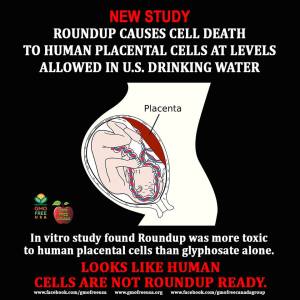
Image source: http://healthimpactnews.com/2015/study-roundup-causes-cell-death-to-human-placenta-cells-at-levels-allowed-in-drinking-water/
NEW STUDY: A NEW, 2015 in-vitro study found that Roundup herbicide kills human placental cells at levels allowed in both Australian and U.S. drinking water. The study, done in Australia, found that Roundup herbicide was even more toxic to human cells than it’s main constituent, glyphosate alone and suggests that future studies be conducted on the full formula herbicide, Roundup, and not glyphosate alone. This is the first study to examine the effects of glyphosate and Roundup on progesterone production, which it found to be adversely affected by the death of the placental cells. The study examined human female cells in an in vitro system that models key aspects of reproduction in women.
Looks like human cells are not “Roundup Ready”. Are you surprised?
Don’t believe me? READ THE STUDY: http://www.gmoevidence.com/wp-content/uploads/2015/03/IPTG-1-104.pdf
In fact, samples of popular PediaSure, a supposed “nutritional” drink given to ill children in pediatric units, tested positive for unsafe levels of glyphosate.
The following expose is from the website, Mom’s Across America:
Moms Across America finds it appalling that our health care providers have been led to believe this feeding tube liquid is safe. Our children and loved ones who are depending on our health institutions to support their immune system and recovery. Instead they are being fed a liquid which scientists and knowledgeable care givers now believe is doing the exact opposite.
The Pediasure Enteral Nutritional Drink tested is loaded with GM corn syrup, soy, and sugar, which have been shown to cause inflammation, and are sprayed with gyphosate [sic] during the growing season and at harvest as a drying agent. Moms Across America finds it appalling that our health care providers have been led to believe this feeding tube liquid is safe. Our children and loved ones who are depending on our health institutions to support their immune system and recovery. Instead they are being fed a liquid which scientists and knowledgeable care givers now believe is doing the exact opposite.
Glyphosate is scientifically accepted to function as a chelator; which draws out the vital nutrients of any living thing it touches.
It is a patented antibiotic; destroying gut bacteria, where 70% of the immune system lies, and the body’s ability to create Tryptophan/Serotonin, and Melatonin, which regulate insulin/diabetes and protect from sleeplessness, depression, bipolar and violent behavior.
It is a proven endocrine disruptor (and teratogenic—in part by its interference with vitamin A signaling!); which impacts, deforms or halts the development of a fetus, leading to miscarriage, birth defects, infertility and sterility.
It is also a cell disintegrator (Samsel A, Seneff S. 2013); breaking down the blood brain barrier and allowing toxins into the brain (a potential vector for autism).
The rise of autism is 99% correlated with the increased use of glyphosate. New studies find glyphosate also feeds antibiotic resistant bacteria. (see reference in PDF below)
The Pediasure Enteral Nutritional Drink tested is loaded with GM corn syrup, soy, and sugar, which have been shown to cause inflammation, and are sprayed with gyphosate [sic] during the growing season and at harvest as a drying agent. A description of how glyphosate impacts the body from MIT PhD. scientist Stephanie Seneff:
1) Glyphosate is an antimicrobial agent (antibiotic) and it preferentially kills the good bacteria, which causes an overgrowth of pathogens in the gut. This leads to leaky gut syndrome and inflammatory issues.
2) Glyphosate chelates rare minerals like manganese, cobalt, molybdenum, copper, iron, sulfur, selenium, etc., and this disrupts the management of these very important nutrients throughout the body. The minerals end up piling up in the wrong places, causing both toxicity and deficiency at the same time.
3) Glyphosate disrupts cytochrome P450 enzymes in the liver, which are important for many things, two of which are activating vitamin D and detoxifying multiple toxic chemicals and drugs. Acetaminophen (Tylenol), for example, becomes toxic when these enzymes aren’t working.
4) Glyphosate works synergistically with the aluminum, mercury, and glutamate in vaccines to cause much greater harm than would be the case if there were no glyphosate present in the blood when the vaccine was administered.
5) Glyphosate interferes with the shikimate pathway, which is used by both microbes and plants to produce the essential aromatic amino acids. Our own cells don’t have this pathway, and they depend upon food sources and synthesis by gut microbes to supply these nutrients. They are precursors to many biologically important molecules such as the neurotransmitters serotonin, melatonin, dopamine, and norepinephrine, melanin, vitamin E, vitamin K, etc.”
MORE BREAKING NEWS:

The World Health Organization’s International Agency for Research on Cancer (IARC) has just declared glyphosate (all by itself, non-amplified by the rest of what is in toxic Roundup herbicide, including tallowamines used as surfactants and other toxic compounds —projected in combination to be up to 10,000 times MORE toxic than glyphosate alone) a “probable carcinogen.” The W.H.O.’s International Agency for Research on Cancer (IARC) reviewed five organophosphate pesticides in an article published in The Lancet Oncology. Three of them – malathion, diazinon and glyphosate (by far the world’s most widely used herbicide) – were rated by the world’s top cancer researchers as “probably carcinogenic” for humans. The research conclusion was actually based on several studies published in peer-reviewed publications and government reports, and rightfully–for obvious reasons– excluded those submitted by industry groups (the Industry’s own safety data on its pesticides are a “commercial secret”. Independent scientists and the public are not even allowed to see them). The terms “probable carcinogen” and “limited evidence” used in the study, according to the IARC, means that studies have positively linked exposure to glyphosate to cancer in people, but chance and experimental bias could not be totally ruled out as the cause of that link.
Then again, smoking was also once categorized as a merely “probable” carcinogen to humans, as well…
According to the IARC study there was more than sufficient evidence in animals, technically “limited” but compelling evidence in humans and very strong supporting evidence showing DNA mutations … and damaged chromosomes (known to precede all cancer development). Monsanto (having representatives operating in all major political cabinets throughout the world) has built a $59.83 billion+ company (as of May 2014) on sales of glyphosate-based Roundup herbicide, not to mention its GMO crops that have been questionably genetically engineered to (among other questionable things) tolerate being saturated with toxic Roundup. –And Monsanto battles every single legislative bill and consumer initiative attempting to establish basic, simple labeling of GMO-containing foods (GMO crops are already totally banned in at least 65 countries around the world for innumerable sound reasons. – Watch the excellent documentary film ‘Genetic Roulette’ for free online for a superb overview of the fascinating, important and exhaustively researched disturbing facts). In fact, just FYI–there is currently even a Monsanto-friendly Industry “dream bill” that was just submitted to the US congress (HR 1599) attempting to make basic labeling of GMO foods ILLEGAL. If GMO’s are so gosh-darn good for us, why then is Monsanto so afraid of us knowing when it’s in our food?
Oh—and did I mention the irony that “probably carcinogenic” glyphosate has been found in the very parenteral formulas fed to children with cancer in hospitals through their feeding tubes?
Anything wrong with this picture?
Think that’s all?
According to Dr. Kelly Brogan, MD and Sayer Ji in an article titled “Monsanto’s Darkest Secret: Roundup’s Effect On The Fetus”:
Earth Open Source, a group of independent scientists (think: not paid to scientifically support corporations) published a compendium of literature that they called “Roundup and Birth Defects: Is the public being kept in the dark?” stating, “The pesticide industry and EU regulators knew as long ago as the 1980s-1990s that Roundup, the world’s best selling herbicide, causes birth defects – but they failed to inform the public. The report was the byproduct of an international collaboration of concerned scientists and researchers, and reveals in shocking clarity how the industry’s own studies show Roundup causes birth defects in laboratory animals. One of the damning studies was even commissioned by Monsanto, the manufacturer of the herbicide.
The findings of the report were summarized as follows:
- Industry has known from its own studies since the 1980s that glyphosate causes malformations in experimental animals at high doses
- Industry has known since 1993 that these effects also occur at lower and mid doses
- The German government has known since at least 1998 that glyphosate causes malformations
- The EU Commission’s expert scientific review panel knew in 1999 that glyphosate causes malformations
- The EU Commission has known since 2002 that glyphosate causes malformations. This was the year it signed off on the current approval of glyphosate.
The EU Commission had previously ignored or dismissed many other findings from the independent scientific literature showing that Roundup and glyphosate cause endocrine disruption, damage to DNA, reproductive and developmental toxicity, neurotoxicity, and cancer, as well as birth defects. Many of these effects are found at very low doses, comparable to levels of pesticide residues found in food and the environment, challenging the notion that there is such thing as a “safe threshold” of exposure. Effects likely to be missed include endocrine disruption, effects on development, amplifying the effects of added ingredients (adjuvants), effects of combinations of chemicals, and effects on bees. Also likely to be missed are effects found in independent peer reviewed scientific literature, as the old directive does not explicitly say that such studies must be included in industry’s dossier.
In the realm of persistent and bioaccumulative pesticides and herbicides, testing only the active ingredient or “AP” may leave manufacturers falsely reassured. Toxicant synergy has exploded the simplistic notion of “the dose makes the poison” and a critical paper in Biomed Research International entitled Major Pesticides Are More Toxic to Human Cells Than Their Declared Active Principles aimed to address flawed assumptions around pesticide and herbicide toxicity, finding that Monsanto’s Roundup may be up to 10,000 times more toxic than glyphosate alone.
STILL MORE TROUBLE WITH COMMERCIALLY AVAILABLE INFANT FORMULAS:
A study published in 2009 in the peer reviewed journal, Kidney International additionally demonstrated concerns about the contaminant known as “melamine” in commercial infant formulas, stating that “Recent outbreaks of nephrolithiasis (kidney stones) and acute kidney injury among children in China have been linked to ingestion of milk-based infant formula contaminated with melamine. These cases provide evidence in humans for the nephrotoxicity of melamine, which previously had been described only in animals. The consequences of this outbreak are already severe and will likely continue to worsen.”
The researchers went on to say that:
“This epidemic of environmental kidney disease highlights the morbidity associated with adulterated food products available in today’s global marketplace and reminds us of the unique vulnerability of the kidney to environmental insults. Melamine is the latest in a growing list of diverse potentially toxic compounds about which nephrologists and other health-care providers responsible for the diagnosis and management of kidney disease must now be aware.”
I think we can be quite certain that kidney issues aren’t the only casualty of the mainstream health authority “approved” processed and chemical/GMO/pesticide-tainted food supply and infant formulas. The vitamins in these formulas are synthetic and even (in the case of dl-alpha tocopherol and its B-vitamins) petroleum derived. Also, many of the so-called “minerals” added to commercial infant formulas are not even naturally found in food! They are either totally inorganic and (at best) non-compatible with human physiology or amount to being little more than toxic mineral waste products from the mining and chemical industries. Examples include substances such as copper/cupric sulfate, (used industrially as an herbicide, insecticide fungicide and additionally to kill algae and mollusks) and sodium selenate (a toxic byproduct of copper metal refining–not allowed in public drinking water in the US above 50 parts per billion according to EPA Federal Drinking Water Standards due to concerns associated with its toxicity).
A material safety data sheet on cupric sulfate, an ingredient in almost every commercial infant formula clearly defines the following:
Potential Acute Health Effects:
- Hazardous in case of skin contact (irritant), of eye contact (irritant), of ingestion, of inhalation.
Potential Chronic Health Effects:
- CARCINOGENIC EFFECTS: Not available.
- MUTAGENIC EFFECTS: Mutagenic for mammalian somatic cells.
- TERATROGENIC EFFECTS: Not available.
- DEVELOPMENT TOXICITY: Not available.
- The substance may be toxic to kidneys, liver. Repeated or prolonged exposure to the substance can produce target organs damage.”
And it also says:
“Do not ingest. Do not breathe dust. Wear suitable protective clothing. In case of insufficient ventilation, wear suitable respiratory equipment. If ingested, seek medical advice immediately and show t he container or the label. Avoid contact with skin and eyes. Keep away from incompatibles such as metals, alkalis.”
The following popular commercially formulated industrial chemical cocktail (and innumerable others like it) is among those considered by mainstream authorities to be the only “acceptable” and “safe” type of infant formulation—even fed to sick babies in hospitals. This is the ingredient list that the howling, self-righteous diet dictocrats consider some sort of superior alternative when breast milk isn’t available (also, ironically, all containing synthetic vitamin A, among other even more damaging substances, like toxic glyphosate and Roundup herbicide residues)?
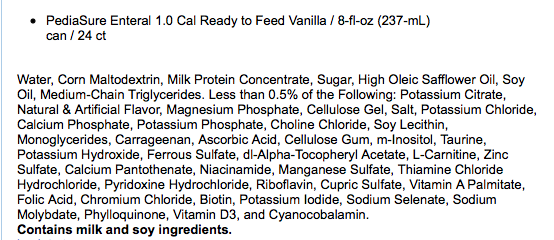
Note the presence of “cupric” (copper) sulfate and sodium selenate on the above ingredient list (i.e., industrial waste products and known toxic substances included as “minerals” for babies). This product and others like it also contains highly antigenic (milk, corn and soy products/byproducts), inflammatory/endocrine dysregulating (maltodextrin, sugar, table salt, soy oil), trans fats (soy oil), GMO-related products (soy and corn) along with carcinogens (probable GMO pesticide residues and carrageenan), all-synthetic “vitamins”, inorganic (and/or potentially toxic) minerals such as ferrous sulfate and all other non-food “minerals” in this formula, along with “artificial flavors.” All approved for babies.
But what about commercial infant formulas made for more “sensitive” infants?
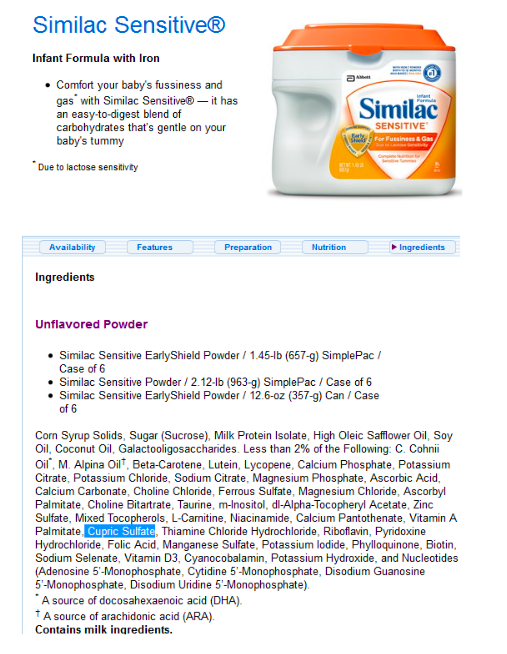
Gee…yet another toxic baby formula containing…you guessed it: cupric sulfate (along with toxic, chromosome-damaging sodium selenate, sodium selenite, ferrous sulfate, manganese sulfate, zinc sulfate, calcium chloride, potassium hydroxide, calcium chloride and all the other established-as-problematic suspects).
Even many supposed “organic” commercial formulations aren’t any better. Case in point, the following product. Check out the scary ingredient list at the company’s own web site: http://www.earthsbest.com/products/product/2392310040
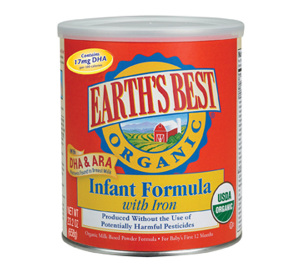
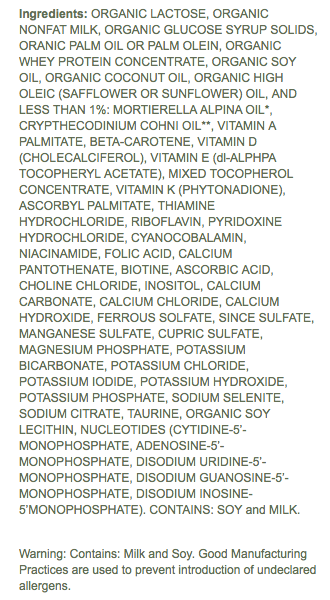
And all this barely touches the tip of the risks associated with commercial infant formula:
- Formula-fed infants have a higher risk of childhood cancers
- Candida occurrence in oral cavities is more prevalent in formula fed infants than breast-fed ones
- Commercial cow’s milk-based infant formula increases the risk for Type 1 diabetes
- Increased risk of serious infections in babies (including bacterial meningitis, necrotizing enterocolitis, and sepsis associated with powdered commercial infant formulas
- Diarrhea, lower respiratory tract infection and more frequent hospitalization associated with commercial infant formulas
- Commercial formula feeding skews immune cell composition toward adaptive immunity and delayed recruitment of innate immunity cells in infants compared to breastfeeding
- Formula fed infants may have stunted synaptogenesis and slower neurodevelopment
- “Immunological programming by breast milk creates an anti-inflammatory cytokine milieu in breast-fed infants compared to formula-fed infants”
- Infant feeding with soy-based infant formulas has an adverse effect on puberty, reproductive function and testicular cell numbers in monkeys
- “Formula feeding is associated with increased hospital admissions due to infections among infants younger than 6 months in Manila, Philippines”
- Breastfed infants induce a greater phagocytic capacity against C. albicans (Candida infection) in neutrophils than serum from formula-fed infants
- Infants consuming commercial formula are at greater risk for sudden infant death syndrome (SIDS)
And on and ON…
Officially sanctioned Russian roulette for your babies, anyone?
A US review in 2002 summarized the following:
“Infant formula, like no other food, is regulated by its own law, the Infant Formula Act of 1980 as amended in 1986. The act sets lower limits on 29 nutrients (so-called “table nutrients” because they appear in table form. U.S. Code of Federal Regulations 21 CFR 107.100). . . . Manufacturers are required to follow “good manufacturing practice,” but no requirement for sterility is specified . . . Powdered formula is not guaranteed nor required to be free of pathogenic organisms .” (Baker, 2002).
Still trust those mainstream, corporate controlled health and nutrition policy-making authorities and the products they endorse (and/or condemn)?
Are these carcinogenic, pesticide-laden and highly processed mainstream formulas what Charlotte Carr (and other moms in her predicament) are supposed to feed her baby instead of the natural, time-tested, nutritious and nutrient dense, WHOLE-FOOD-BASED liver recipe she carefully researched and formulated for her own son—only after she found she could not use her own breast milk for him? A natural formula that unquestioningly and very positively transformed his health, by the way? If I were a mother in her position I would want—more than anything—to know this recipe.
MORE SCARY FACTS
According to a study done in 2004 by the Centers for Disease Control and Prevention, only about 11% of new mothers rely exclusively on breastfeeding; which implies that most infants are exposed to these commercial formulas at some point. It may be why the US today (in 2015) has among the highest rate of infant mortality and poor child health in the industrialized world (ranking #31 out of the world’s 47 developed countries). Also today, children are expected—for the first time in recorded history—to develop diseases and die 33% earlier than their grandparents. Age 30 has become the new 45 with respect to on-setting disease. Let’s just say that commercially prepared, processed and toxin-laden infant formulas aren’t helping—along with the rest of what comes with the mainstream food supply and the government guidelines that have led us all here. These government guidelines have NOT made us healthier—they have progressively eroded our collective health the more closely we have followed them.
“The Infant Nutrition Council based in Australia makes a claim similar to the one by the Infant Formula Council in the U.S.: “Infant formula has been specifically developed to contain all the necessary ingredients needed to meet an infant’s nutritional requirements” (Infant Nutrition Council, 2011)…How would they explain the fact that formula feeding leads to worse health outcomes than breastfeeding?”
Also, according to the same researcher, “If we assess formula by its results, rather than by whether its ingredients matched a specific list, we would have to conclude that there has never been an infant formula that would “satisfy,” by itself, the nutritional requirements of infants during the first months of life.”
SOMEONE has some explaining to do—and it isn’t Pete Evans, Helen Padarin or Charlotte Carr.
So where’s the “altruistic” health authority and media outcry regarding GMO’s, RoundUp/glyphosate pesticide-containing and/or soy-based, partially hydrogenated, contaminated and chemically-laden commercial infant formulas? Hm? Still think a little liver and bone broth is the problem?
With respect to the Bubba Yum Yum baby formula alternative (now forcibly renamed: “Happy Tummy Brew”—replacing the former name of ‘DIY Baby Milk Formula’ in the book), the media flap both in Australia and as far away as the US has been incomprehensibly sensationalistic. And ALL because there is a significant amount of naturally occurring, vitamin A in liver as one ingredient. SERIOUSLY? “Professor” Heather Yeatman, president of the Public Health Association of Australia, told The Weekly (online) that “In my view, there’s a very real possibility that a baby may die if this book goes ahead.”
OMG—she actually said this?
GETTING DOWN TO IT
The following laboratory analysis illustrates what all the “baby killing” rhetoric is about:
The whole food-based, liver-containing Bubba Yum Yum “Happy Tummy Brew” recipe contains (drumroll please): 2,256 IU of naturally occurring, organic, whole food-based vitamin A per 200 ml serving (6.25 μg or .676800032 mg). Most babies will consume less than that in a serving, but they have accounted for a maximum feeding. They are recommending the use of this particular recipe up to three times per day all of twice per week.
They also are clear to state that—wherever humanly possible—breastfeeding is always best.
This is what all of the hubbub about the dangers of vitamin A-rich, Paleo-friendly baby food is all about. Perhaps the greater danger with this formula is the threat to profits when it comes to commercially available baby formulas—After all, the global market for the far more questionable commercial infant formulas is at an estimated 7.9 billion dollars annually. The fear mongering, mainstream authorities, corporate and tabloid press decrying this book should literally be no less than ashamed of themselves.
Someone owes Charlotte Carr, Helen Padarin and Pete Evans (along with the rest of us…including babies everywhere) a major apology.
And soon.
NUTRITIONAL ANALYSIS OF COMMERCIAL FORMULA AND HAPPY TUMMY BREW
Click for the full nutritional analysis PDF: Nutritional_Analysis
IF YOU WOULD LIKE THE FULLY REFERENCED VERSION OF THIS ARTICLE COMPLETE WITH 147 CITATIONS, PLEASE CLICK THIS LINK: VITAMIN A UNDER ATTACK DOWN UNDER
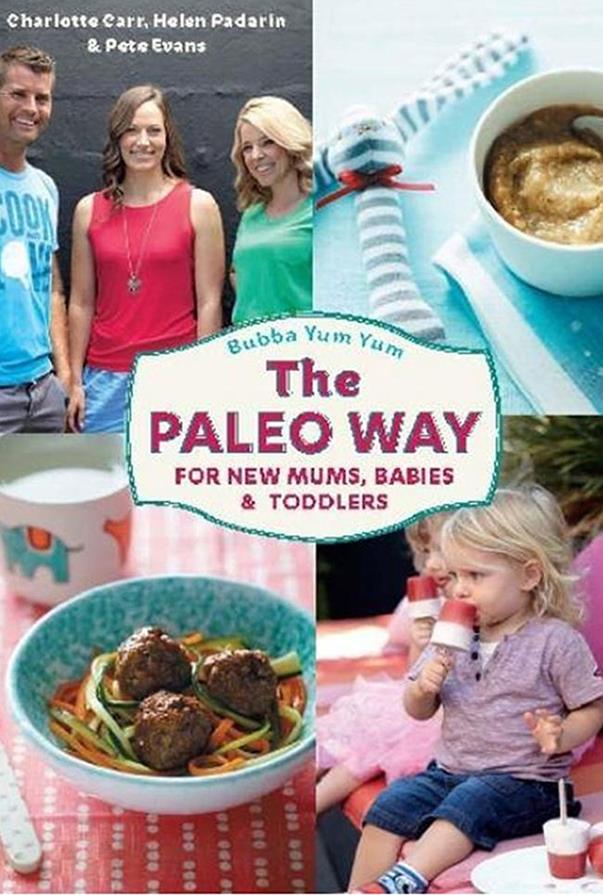



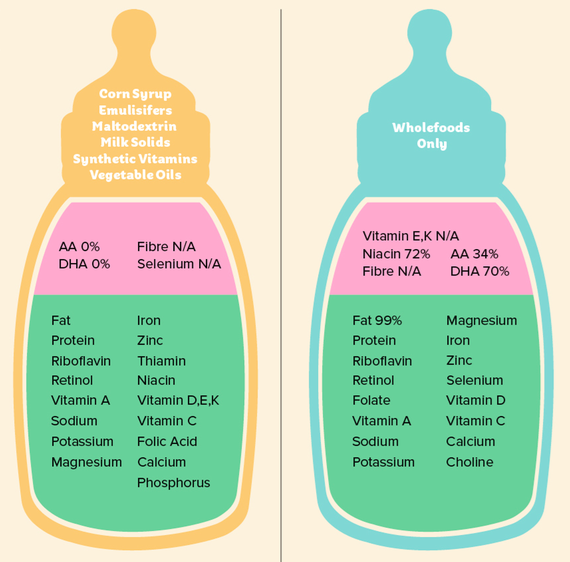



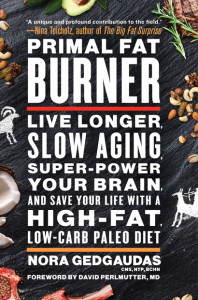
Thank you so much Nora! All this media BS can really piss any reasonable person off!! We desperately need more voices like yours. Voices that do the research and know their stuff. Forever grateful, Kate
Filed under “Don’t get me started”….I love that and Nora I love You!
I have utmost admiration for you and I loved that article, I loved everything about it. As well as your humour from anger and frustration.
I read your book PB PM several years ago, went to the Paleo Way and listened to you in Sydney and your message is clear.
For far too long we have been fooled and the greater population remains that way.
Speak up more often lovely lady, your message is succinct and clear. Your knowledge, clarity, depth and wisdom makes this world a much better place.
The tide is turning, albeit slowly.
I’m just a little fry trying to make a difference in my neck of the woods, to spread the message to those around me, starting with a love for the health of the land and all of it’s inhabitants.
My best to you on your journey and know that many of us support you and your associates who are speaking the truth, all the way!
Linda
Great stuff Nora.
Thank you for standing up for babies.
Norah
Incredible. Thanks for the long and in depth article. I’ll be coming back to finish it off. It’s a huge, but worthy read.
Our baby is enjoying the extra dose of quality vitamin A, thanks to you, Helen, and Charlotte’s good work.
What a brilliant article Nora. You are just such a calm and well-researched voice in the storm. If only 1 person who previously feared Vit A reads this with an open mind (there must be 1 person out there, right?!) and tells someone else then it was worth the obvious length of time and effort you have spent on this post. I wish I had a million Twitter followers and could force them to read your works. You are my absolute hero. Keep up the GREAT work and keep it coming! AC.
Dr. Max Gerson prescribed 3 fresh, raw liver juices per day for his cancer patients, every single day until they we well. This could take up to two years. None of his patients every experience vitamin A toxicity in spite of consuming upwards of 150,000 IU per day. Patients who included liver juice in there dietary therapy had significantly better survival rates than those who did not per this retrospective analysis that I helped do.
http://gerson-research.org/docs/HildenbrandGLG-1996-1/index.html
“Conclusions. Self-selecting adult melanoma patients utilizing Gerson’s aggressive nutritional intervention have achieved far better stage-related 5-year survival rates than have been reported elsewhere in the literature. Within the Gerson system, advanced (nonlocal disease) patients who combined surgery with Gerson’s therapy enjoyed a more than doubled 18 month-survival rate when compared with those who relied on only non-surgical treatment. ***At 18 months, patients who received liver juice achieved a 70% greater survival advantage than did those whose supply was interrupted by contamination or discontinued altogether.*** These outcomes led to changes in clinical practice.”
Hi Nora, thanks again for such a credible, well-researched, articulate article that addresses the lies, hysteria, ignorance and irresponsible and negligent material being pedalled by the media, the grain-agriculture-industry-backed Dieticians Association, the pharmaceutical-dependent medicos and their associated cronies. No wonder children in Australia are showing increased levels of ADD/ADHD, allergies, early onset endocrine disorders, obesity and associated health issues. It’s a disgrace. I thank you and Pete Evans and Charlotte Carr for your collective bravery in standing up to the ignorance and the wall of deceit and frankly bad medicine and bad health management Australia supports and endorses. As Schopenhauer said: “All truth passes through three stages. First, it is ridiculed (well we know that). Second, it is violently opposed. (Poor Pete Evans – people are awful). Third, it is accepted as being self-evident”. Well, hallelujah, bring on the third stage as soon as possible! Thanks Nora! (and Pete and Charlotte)
Great information and so comprehensive thank-you. I have loaded this into my reading list to read in more detail later. The absolutely pathetic formula that is marketed as suitable for a child to ingest is beyond belief. But then – the DAA also recommend limiting saturated fats and cooking in canola oil on their website so it’s hardly surprising they are way off track when it comes to feeding infants.
where can l purchase this book ? As l’m sure l will become a Grandmother one day, Just wish l had this info before l had children….forgive me my children!!
l’m an Australian living in New Zealand.l have just finished reading Primal fat Burner, WOW……….
And to you Nora……. thank you so very much…..!!!